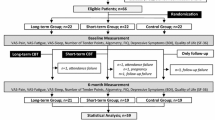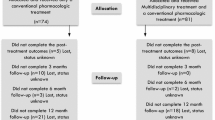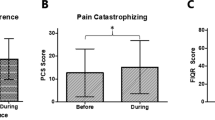Abstract
Background
Currently, there is no definitive cure for fibromyalgia. Instead, treatments focus of reducing symptoms and disability.
Aims
This randomized controlled study aimed to evaluate the effectiveness of perceptive rehabilitation and soft tissue and joint mobilization on the severity of symptoms and disability in fibromyalgia compared with a control group.
Methods
A total of 55 fibromyalgia patients were randomized into three groups: perceptive rehabilitation, mobilization, and control. The impact of fibromyalgia was evaluated using the Revised Fibromyalgia Impact Questionnaire (FIQR; primary outcome). Pain intensity, fatigue severity, depression, and sleep quality were secondary outcome measures. Data were collected at baseline (T0), the end of treatment (8 weeks; T1), and the end of 3 months (T2).
Results
Statistically significant differences were found in between-groups comparisons at T1 for primary and secondary outcome measurements (p < .05), except for sleep quality. Both the perceptive rehabilitation and mobilization groups had statistically significant differences at T1 over the control group (p < .05). Between-group pairwise comparisons showed statistically significant differences between the perceptive and control groups for all outcome measures at T1 (p < .05). Similarly, statistically significant differences existed between the mobilization and control groups for all outcome measures at T1 (p < .05), except the FIQR overall impact scores. All other variables except depression were statistically similar between groups at T2.
Conclusion
This study shows that perceptive rehabilitation and mobilization therapy are similarly effective in improving fibromyalgia symptoms and disability, but the effects disappear within 3 months. Further research is needed to understand how the improvements could be maintained longer.
Trial Registration
Clinical Trial Registration number, ClinicalTrials.gov Identifier: NCT03705910.



Similar content being viewed by others
References
Chafer S, Hamilton F (2015) Efficacy of manual therapy as a treatment for fibromyalgia patients. J Phys Ther Health Promot 3(3):28–38. https://doi.org/10.18005/PTHP0303001
Clauw DJ, Arnold LM, McCarberg BH (2011) FibroCollaborative. The science of fibromyalgia. Mayo Clin Proc 86(9):907–11. https://doi.org/10.4065/mcp.2011.0206
Clauw DJ (2014) Fibromyalgia: a clinical review. JAMA 311(15):1547–1555. https://doi.org/10.1001/jama.2014.3266
Garrido-Ardila EM, González-López-Arza MV, Jiménez-Palomares M et al (2021) Effects of physiotherapy vs. acupuncture in quality of life, pain, stiffness, difficulty to work and depression of women with fibromyalgia: A randomized controlled trial. J Clin Med 10(17):3765. https://doi.org/10.3390/jcm10173765
Alciati A, Nucera V, Masala IF et al (2021) One year in review 2021: Fibromyalgia. Clin Exp Rheumatol 39(3):S3–S12. https://doi.org/10.55563/clinexprheumatol/gz4i3i
Häuser W, Fitzcharles MA (2018) Facts and myths pertaining to fibromyalgia. Dialogues Clin Neurosci 20(1):53–62. https://doi.org/10.31887/DCNS.2018.20.1/whauser
Theoharides TC, Tsilioni I, Arbetman L et al (2015) Fibromyalgia syndrome in need of effective treatments. J Pharmacol Exp Ther 355(2):255–263. https://doi.org/10.1124/jpet.115.227298
Busch AJ, Overend TJ, Schachter CL (2009) Fibromyalgia treatment: the role of exercise and physical activity. Int J Clin Rheumatol 4(3):343–380. https://doi.org/10.2217/ijr.09.23
Antunes M, Schmitt AC, Marques A (2021) Amigos de fibro (fibro friends): Development of A multidisciplinary health promotion program for fibromyalgia in Brazil.J Clin Rheumatol 27:s112. https://doi.org/10.1097/RHU.0000000000001781
Antunes MD, Marques AP (2022) The role of physiotherapy in fibromyalgia: Current and future perspectives. Front Physiol 1701. https://doi.org/10.3389/fphys.2022.968292
Castro-Sánchez AM, Aguilar-Ferrándiz ME, Matarán-Peñarrocha GA et al (2014) Short-term effects of a manual therapy protocol on pain, physical function, quality of sleep, depressive symptoms, and pressure sensitivity in women and men with fibromyalgia syndrome: a randomized controlled trial. Clin J Pain 30(7):589–597. https://doi.org/10.1097/AJP.0000000000000008
Schulze NB, Salemi MM, de Alencar GG et al (2020) Efficacy of manual therapy on pain, impact of disease, and quality of life in the treatment of fibromyalgia: a systematic review. Pain Physician 23:461–476. https://doi.org/10.36076/ppj.2020/23/461
Bialosky JE, Beneciuk JM, Bishop MD et al (2018) Unraveling the mechanisms of manual therapy: modeling an approach. J Orthop Sports Phys Ther 48:8–18. https://doi.org/10.2519/jospt.2018.7476
Morone G, Iosa M, Paolucci T et al (2012) Efficacy of perceptive rehabilitation in the treatment of chronic nonspecific low back pain through a new tool: a randomized clinical study. Clin Rehabil 26:339–350. https://doi.org/10.1177/0269215511414443
Paolucci T, Baldari C, Di Franco M et al (2016) A New Rehabilitation Tool in Fibromyalgia: The Effects of Perceptive Rehabilitation on Pain and Function in a Clinical Randomized Controlled Trial. Evid Based Complement Alternat Med 2016:7574589. https://doi.org/10.1155/2016/7574589
Paolucci T, Fusco A, Iosa M et al (2012) The efficacy of a perceptive rehabilitation on postural control in patients with chronic nonspecific low back pain. Int J Rehabil Res 35:360–366. https://doi.org/10.1097/MRR.0b013e328356427c
Cohen J (1988) Statistical power analysis for the behavioral sciences. 2nd ed. New York: United States of America: Lawrence Erlbaum Associates Publishers
Lehmann EL, Nonparametrics: Statistical methods based on ranks. (2006) New York. Springer, NY
Evans S, Royston P, Day S. Minim: allocation by minimisation in clinical trials by. Available from http://www-users.york.ac.uk/~mb55/guide/minim.htm. Accessed 10 Jan 2022
Wolfe F, Clauw DJ, Fitzcharles MA et al (2016) 2016 Revisions to the 2010/2011 fibromyalgia diagnostic criteria. Semin Arthritis Rheum 46(3):319–329. https://doi.org/10.1016/j.semarthrit.2016.08.012
UNESCO Institute for Statistics (2012) International standard classification of education: ISCED 2011. Montreal: UNESCO Institute for Statistics. Available from https://doi.org/10.15220/978-92-9189-123-8-en. Accessed 25 Feb 2021
Bennett RM, Friend R, Jones KD et al (2009) The revised fibromyalgia impact questionnaire (FIQR): validation and psychometric properties. Arthritis Res Ther 11(4):120. https://doi.org/10.1186/ar2783
Ediz L, Hiz O, Toprak M et al (2011) The validity and reliability of the turkish version of the revised fibromyalgia impact questionnaire. Clin Rheumatol 30(3):339–346. https://doi.org/10.1007/s10067-010-1546-8
Beck AT, Ward CH, Mendelson M et al (1961) An inventory for measuring depression. Arch Gen Psychiatry 4(6):561–571. https://doi.org/10.1001/archpsyc.1961.01710120031004
Kapci EG, Uslu R, Turkcapar H et al (2008) Beck Depression Inventory II: evaluation of the psychometric properties and cut-off points in a Turkish adult population. Depress Anxiety 25(10):E104–E110. https://doi.org/10.1002/da.20371
Krupp LB, LaRocca NG, Muir-Nash J et al (1989) The fatigue severity scale. Application to patients with multiple sclerosis and systemic lupus erythematosus. Arch Neurol 46(10):1121–1123. https://doi.org/10.1001/archneur.1989.00520460115022
Gencay-Can A, Can SS (2012) Validation of the Turkish version of the fatigue severity scale in patients with fibromyalgia. Rheumatol Int 32(1):27–31. https://doi.org/10.1007/s00296-010-1558-3
Buysse DJ, Reynolds CF 3rd, Monk TH et al (1989) The Pittsburgh Sleep Quality Index: a new instrument for psychiatric practice and research. Psychiatry Res 28(2):193–213. https://doi.org/10.1016/0165-1781(89)90047-4
Agargun MY, Kara H, Anlar Ö (1996) Validity and reliability of the Pittsburgh Sleep Quality Index. Turk Psikiyatri Derg 7(2):107–115. https://doi.org/10.5606/ArchRheumatol.2018.6376
Duncan R (2014) Myofascial release: Human Kinetics. Champaign, US: Elsevier Health Sciences
Nadal-Nicolás Y, Rubio-Arias JÁ, Martínez-Olcina M et al (2020) Effects of manual therapy on fatigue, pain, and psychological aspects in women with fibromyalgia. Int J Environ Res Public Health 17(12):4611. https://doi.org/10.3390/ijerph17124611
Løge-Hagen JS, Sæle A, Juhl C et al (2019) Prevalence of depressive disorder among patients with fibromyalgia: systematic review and meta-analysis. J Affect Disord 245:1098–1105. https://doi.org/10.1016/j.jad.2018.12.001
Ughreja RA, Venkatesan P, Gopalakrishna DB et al (2021) Effectiveness of myofascial release on pain, sleep, and quality of life in patients with fibromyalgia syndrome: A systematic review. Complement. Ther Clin Pract 45:101477. https://doi.org/10.1016/j.ctcp.2021.101477
Macfarlane GJ, Kronisch C, Dean LE et al (2017) EULAR revised recommendations for the management of fibromyalgia. Ann Rheum Dis 76(2):318–328. https://doi.org/10.1136/annrheumdis-2016-209724
Yoshikawa K, Brady B, Perry MA et al (2020) Sociocultural factors influencing physiotherapy management in culturally and linguistically diverse people with persistent pain: a scoping review. Physiotherapy 107:292–305. https://doi.org/10.1016/j.physio.2019.08.002
Garijo IH, Del Barrio SJ, Gómez TM et al (2021) Effectiveness of non-pharmacological conservative therapies in adults with fibromyalgia: A systematic review of high-quality clinical trials. J Back Musculoskelet Rehabil. https://doi.org/10.3233/BMR-200282.10.3233/BMR-200282
Cetin A, Gokdemir MT (2019) Fatigue severity scale, fibromyalgia impact questionnaire, and visual pain scale scores in patients with fibromyalgia. Ann Med Res 26(3):389–392. https://doi.org/10.5455/annalsmedres.2019.01.034
Author information
Authors and Affiliations
Corresponding author
Ethics declarations
Author disclosure statement
Authors state no conflict of interest.
Additional information
Publisher's Note
Springer Nature remains neutral with regard to jurisdictional claims in published maps and institutional affiliations.
Rights and permissions
Springer Nature or its licensor (e.g. a society or other partner) holds exclusive rights to this article under a publishing agreement with the author(s) or other rightsholder(s); author self-archiving of the accepted manuscript version of this article is solely governed by the terms of such publishing agreement and applicable law.
About this article
Cite this article
Alptug, B., Tüzün, E.H., Keçeci, B. et al. Effects of perceptive rehabilitation and mobilization methods on symptoms and disability in patients with fibromyalgia: A preliminary randomized control trial. Ir J Med Sci 192, 2937–2947 (2023). https://doi.org/10.1007/s11845-023-03333-6
Received:
Accepted:
Published:
Issue Date:
DOI: https://doi.org/10.1007/s11845-023-03333-6




